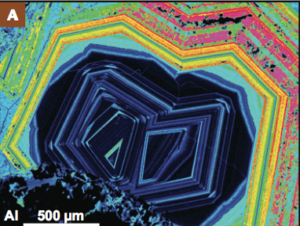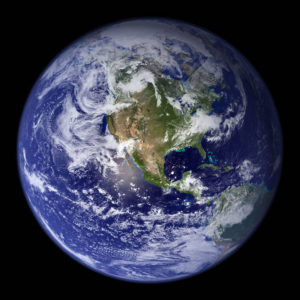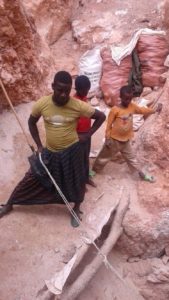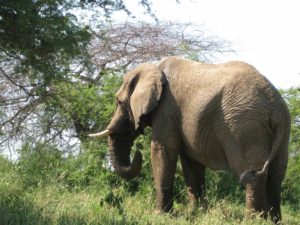Geologist, educator, author, and artist
I’m working on a book about how different people see the Earth.
Here’s what I’m thinking…
The Earth talks to us. What do we do with all that information?
Image Artifact-Based Rendering, courtesy of Francesca Samsel.
more
Think about all the data we can tease from a single grain of sand. A rock might sit around for billions of years – or millions – or tens of thousands. It weathers and falls apart and the grain gets washed down the hill, into a stream, perhaps, and bounces along the bottom or floats as it is caught up in a swollen river. Eventually the rains stop, or the stream runs into a still pool of water. Mud and more sand cover this little grain, burying it beneath thick, heavy piles of sediment, pushing it down into the hot basin. It solidifies into a rock over time, and in billions or millions or tens of thousands of years later, it has moved up to the surface where a geologist picks it up. She writes down her observations of what it looks like, where she got it, what the outcrops look like, and what day it was – thus starting the data collection which tells the story of that little grain’s long and tortuous journey.
The geologist takes it back to the laboratory, crushes it, and places a handful under the binocular microscope. She finds some interesting minerals and plucks them from the crushed rock, puts them on a slide and into a machine that measures the chemistry or perhaps the isotopes, telling her how old that grain is. These data are the ties that link the person today to what happened in the past, possibly billions of years ago.
But all that data are only important if she can figure out what that little grain is telling us. Answers don’t usually come flying off the scientific instruments. I learned about data products when I worked in an organization whose main function was to help acquire and then store geodetic data, the data that tells us the shape of the Earth and where it sits in space. It was one person’s life’s work to take the numbers that came straight off the GPS units, the “first-order data,” and turn that into “second-order data”—numbers that could be then used by techies and scientists. Third-order data was something more easily interpreted by a variety of people who might want to use it—for example, to create a time series showing the movement of the Earth.
In the education business, we wanted to turn the data into fourth-order data—data that was easy to understand visually, or accessible by a wide range of audiences including you and me. With such large amounts of data from our sophisticated, automated, efficient instruments, it takes more than a simple XY graph to understand what’s going on. This is why so many people are using new visualization techniques to illustrate the complex relationships among various parameters. The image associated with this writing is from Francesca Samsel, an artist working with physicists and computer scientists at Los Alamos Laboratory and at UT Austin. She uses sculptural art as visual data to make complex physical phenomena discernable to humans.
Teaching young people how to deal with data is a huge educational challenge in the 21st century. Who has the access to the education needed to interpret all this data? Interpreting the information contained in one little grain is hard enough. How do we figure out what terabytes of data tell us?
☒ Close
How do I answer the person who asks me, “What does geology have to do with climate change?”
New Zealand Kaikoura peninsula with the Seaward Kaikoura Range in the background. The Hope fault is at the base of the mountains. Photo courtesy of T. Gardner, copyright 2015.
more
Climate change is one of the world’s wicked problems, so named because of their complexity. Policy-wonks Rittel and Webble first1 coined the word wicked and characterized a wicked problem as one that is unique to itself; lacks a definitive formula; offers no way to determine when a solution has been discovered; has other, better or worse solutions; is long-term and can’t be tested; can only be implementation is when trying to solve them; has many explanations; and no list of possible solutions.
And finally, my favorite: those who try to solve the problems are held responsible for their actions. In today’s world, I hardly think anyone wants to be held accountable for climate change. This is not the way of the early 21st century!

When I think about the wicked problems of geoscience – and I almost write geology, for I am a geologist, I realize I should clarify the differences between geoscience and geology. Geoscience encompasses the entire earth system – the air, water, oceans, land, and even the geology of the planets. Generally, geology is about earth – the land and, of course, the water on and in the land masses. Atmospheric scientists are geoscientists who study the air – and its relationship with the water, and land. Oceanographers study the oceans. So in response to the question “what does geology have to do with climate change?” I would show the main issues facing each of these subdisciplines of geoscience. And if I keep on listing them—how temperature increase on land is affected by ocean currents, how using electric batteries depends on minerals that both use and contaminate water supplies, and so on—and then draw lines between the topics, it gets so complicated, with interrelationships so dense that I have to take a few minutes to clear my head of the wickedness.
For more answers to this question, you will have to wait for my book.
☒ Close
Are we prepared for the new rush toward mineral exploitation for a green economy?
Sulfur miners in Ijen volcano, East Java, Indonesia. Shutterstock photo.
The current use of the word “harvest” in place of “mining” on the deep-sea floor is another bit of sugar-coating or perhaps green-washing for a process that is difficult and dirty at best. At its worst, mining devastates people, their communities, and the environment.
more
My colleague walked into my office and said “I’m engaged.” “Wow,” I replied, “I’m so happy for you.” After the celebratory hugs and laughter, she said, “I want an engagement ring made of sustainably harvested platinum.”
I couldn’t help but laugh. “Platinum is mined,” I said. “Mining is not sustainable. We use what comes out of mines, and, eventually, it will all be used up. Maybe you mean recycled platinum. Where on earth did you hear about sustainably harvested platinum?” To me, it sounded like a jewelry company’s public relations ploy.
I’ve learned more about mining and sustainability and recycled precious metals in the past decade. I still don’t know what sustainable means to most people; it is a wonderful catchword bantered about that can cover everything from eating fish to the new green-energy craze.
I had forgotten about my colleague’s engagement ring until recently reading an article on deep-sea mining for the metals we think we need to move away from fossil-fuel dependence. This was an excellent, well-written, and highly researched article on the state of exploration for mining the sea floor. The mining companies want to know how to do it; the marine biologists, climate scientists, and environmental advocates want to know how this will impact the biota that live on the sea floor, how sediments will circulate and affect the ocean’s temperature and the currents that drive the global weather patterns, and how the mining itself will affect communities near the sites—as well as the companies that will process the mega-tonnage of materials to extract the targeted metals. We know so little.
I was disturbed, very disturbed, to read in the article’s subtitle that mining the ocean’s floor was called “harvesting” and that the mining would “pluck” the nodules to bring to the surface. In my experience, the word “harvest” applies to things we grow as crops. We normally don’t harvest native forests. We think of autumn as the harvest season when we reap the benefits of nature’s and agriculture’s bounty—wheat, apples, squash, tomatoes, corn. We don’t use the word harvest indiscriminately, however. We “gather eggs,” “make hay,” and “milk the cows.”
We don’t “harvest” coal from the mountains of Kentucky and West Virginia. We “strip mine” it by blasting and bulldozing the tops off mountains to recover the thin layers of coal. We push that mountaintop into the valleys and streams—and most of the time, coal companies don’t reclaim the land like they say they will. This in no way resembles a “harvesting” of coal.
And we won’t see the dredging of the sea floor: the scraping up of sediments in vast quantities, stirring up of mud, and killing of whatever life there is in the mined area. We don’t even know what the life is. We don’t know how the sediments will affect the movement of currents or the stratified temperature zones. We don’t know how much sediment will be moved to recover the few parts per million of the metals.
We don’t know how interacting with our ocean environment in these ways will affect our planet. Maybe it will be even worse than using fossil fuels. We just don’t know.
☒ Close
How do the Earth, planet, and world intersect?
Geological map of central Kentucky, Kentucky Geological Survey.
I thought I was writing about the Earth. It turns out, however, that I am writing about how a person constructs a worldview. In writing about how other people might see the Earth, I’ve learned a lot about my own beliefs and perceptions.
more
The Earth has a mass of 5.972 × 1024kg and moves around the Sun at a speed of 30,000 meters per second. The temperature at its center is around 5,200° Celsius.

It is amazing that we know these statistics about the Earth, but numbers alone don’t trigger in me a great deal of attachment or fondness for such a planet. I’ve never particularly cared about the study of the planets, but one night I sat at the dinner table with a man who studies the wobble of the Earth. I asked what exactly he does to study that phenomenon and he told me he analyzes many GPS sites to find a solution for the entire planet. A solution, in this context is a formula that all the data fit. He looks at the whole to solve this problem – which is not the exclusive purview of nerdy geophysicists but is also our problem, that of the everyday Joe or Josephine. Our use of navigation systems (such as the GPS on our phones) depends on knowing where the satellites are in relation to specific locations on the earth. Hence, we must know how much and in what direction the planet is wobbling at any moment.
Somehow, I feel more affection for a planet that wobbles. The fact that it makes me smile means a wobbling Earth is part of my worldview. And I smile when I think of the gravitational forces that cause the Earth’s tides – the biggest of which makes me think of sitting on a beach ball that gets squished so that its middle expands. I move up and down about 2.5 feet each day as a result of the Earth’s daily deformation from the Moon’s and Sun’s gravitational pull on the solid Earth itself.
☒ Close
How to Be A Jedi in 2022?
Artisan amethyst miners, Mapatiza, Kalomo,Zambia, photo by Daniel Munalula, courtesy of Patricia Ongwe Zita.
Broadening participation in geoscience has rightfully evolved into belonging, accessibility, justice, equity, diversity, and inclusion. In the meantime, geoscience has grown into a community that no longer relies primarily on white people to advocate for these principles. Where do I put my energies now? Natural resource justice for women and children in mining? Continued mentoring of geoscience students?
more
The field of geoscience persists in having one of the lowest percentages of underrepresented minorities as students and as professionals. In the late 20th century, I was the only white person in a room at Virginia Tech telling the Black faculty organization about a new project to increase representation in the sciences. The members asked me why I was there; they didn’t believe there was only one African American geoscientist in a university in Virginia. I still think that was true at the time, but in that moment, I felt quite awkward as the message-bearer.

Children mining beryl in Ethiopia, photo courtesy Hewan Zewdi
I’m more interested now in hanging out with people who are thinking about ethical sourcing of gems and metals, and about the working conditions of men, women, and children in artisan mines. Maybe it is presumptuous to think I, a white woman, can help, but we who buy jewelry and trinkets made of stone know so little about how these rocks are taken from the ground.
I started on this journey using beautiful stone beads I had accumulated over 20 years of attending gem and mineral shows. As I learned more about the business of gemstones, I migrated from wanting simply—and it really is not simple—to know where my rocks came from, to wanting to ensure that the people who touch these stones along their journey have a living wage, safe working conditions, access to school, and some environmental safeguards. This is not an easy task in the jewelry industry—or, as we know from frequent news stories—for many of the modern products that we take for granted!
I do not fit the profile of an entrepreneur—I get a grade of 5 out of 20 on Daniel Isenberg’s quiz in the Harvard Business Review. I’ll stick to education rather than selling jewelry. But I love gemstones and jewelry, and I admire the people in the jewelry industry who are working toward a transparent and ethical trade.
And I still think we need to know where our rocks come from!
☒ Close
How do we escape our silos?
Dunite nodules in basalt, western Victoria, Australia. Photo by S. Eriksson.
“Don’t talk about this” or “Who are you to write about that?” Scientists don’t really want to talk to social scientists, let alone artists. How do we get ‘all hands on deck’ to generate innovative solutions for the world’s pressing problems?
more
A very few years ago, the director of the organization where I worked said, “We need to be more interdisciplinary in our research. Let’s do something with geophysics and geology.” I metaphorically rolled my eyes. (I do that a lot.) The scientific world had already moved beyond subdisciplines working together, I thought—didn’t he know that?

Elephant in Hluhluwe–iMfolozi Park, South Africa, photo by S. Eriksson
Once upon a time, I was told by a colleague not to say the word “theology” in the science building. I’ve also been told that metaphors in science are trivial. Some people—a lot of people—stay in their lanes and want to keep everyone else in their own lanes, too.
There is an alexandrite—a gemstone—that is pleochroic: if you turn it one way, it looks lavender; from another angle, it looks pink. That’s science.
But then there is the fact that we tend to make assumptions based on our limited knowledge or our cultural perspective. A Victorian poem, turned into a song, tells of the men of Hindustan who each approach an elephant, not being able to see the entire animal. They describe the elephant as a wall, a spear, a snake, a tree, a fan, or a rope, depending on which part they touch. Although politically incorrect today, the poem illustrates how we make assumptions based on our limited knowledge.
I could rewrite the song with a different outcome when the men gather to compare what each knows. One last verse might do it, and I’ll work on that when I have nothing else to do.
Fortunately (or not), I have many interests, and I enjoy finding links between and among disparate topics. I am literally a Jack-of-all trades—rather, a Jill-of-all trades—not master nor mistress of only one. Many professions, and I know academia the best, advocate for interdisciplinary, transdisciplinary, or multidisciplinary approaches to problems. Too often, though, people are not rewarded for working across these boundaries.
Most of our wicked problems—those too difficult to know how to solve—demand complex thinking and the expertise of many types of people and disciplines. I’m grappling with how to get people out of their silos to actually affect change.
☒ Close
Biography
As a faculty member and curator of gemstones and minerals at a U.S. university for over two decades, I’ve interpreted the significance of natural objects and contemplated their innate beauty. My career in geological research and education took me to South Africa, Zimbabwe, Australia, and Singapore experiencing different cultures and way of seeing the world. Today, I hold a fairly holistic view of Earth.
I’m author of 13 peer-reviewed papers in academic journals, as well as over 110 published abstracts at professional meetings on topics of geoscience, art and science, writing-across-the-curriculum, educational technology, and the museum profession. I have written and/or contributed to 23 successful grant proposals totaling over $5m. One paper won the Best Paper Award in the publication Rocks and Minerals, and anecdotally, my co-authored article Geodesy in the 21st Century saved NASA’s Earth Mission budget in 2009, which, if true, would be one of my finest achievements.
- Fellow of the Geological Society of America
- Member of The American Geophysical Union
- Patron member of Ethical Metalsmiths
I support various non-profits who work on behalf of civil rights and the fight against hate.
